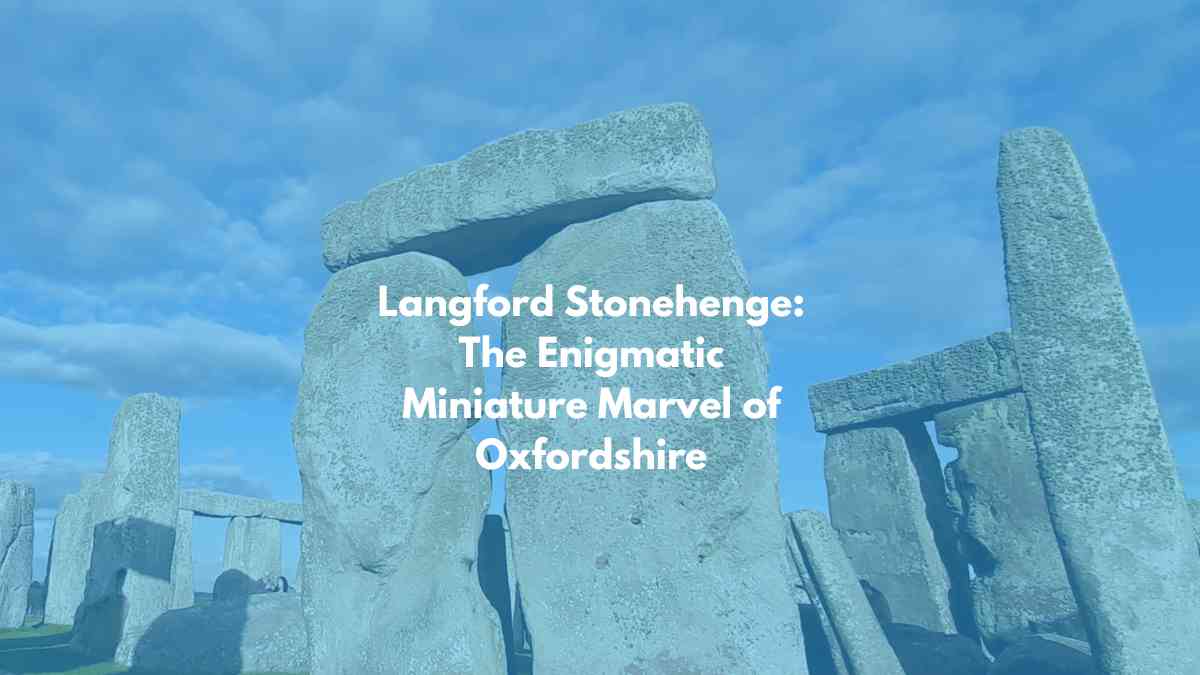Langford Stonehenge: The Enigmatic Miniature Marvel of Oxfordshire

When people hear the word “Stonehenge,” they often picture the iconic prehistoric stone circle on Salisbury Plain. However, nestled in the village of Langford near Bicester in Oxfordshire is a lesser-known yet fascinating site: Langford Stonehenge. Though much smaller and modern in origin, this replica of the famous Stonehenge holds a special charm and continues to intrigue visitors and locals alike.
Langford Stonehenge is not a historical relic, but a whimsical, contemporary tribute to one of Britain’s most recognisable landmarks. Often referred to as the “Mini Stonehenge” or “Bicester’s Stonehenge,” this curious structure invites discussions around public art, community identity, and the British penchant for reinvention.
The Origins of Langford Stonehenge
Unlike its prehistoric counterpart, Langford Stonehenge was not constructed by ancient civilisations but by modern designers and developers. The stone circle was erected as part of a community development in the Langford Village area of Bicester during the late 20th century. Although exact records of its creation remain limited, it was clearly intended as a decorative and thematic nod to the country’s ancient heritage.
Developers often use distinctive sculptures or installations to give character to new neighbourhoods. Langford Stonehenge is a perfect example of this trend—adding an imaginative, whimsical flair to a suburban housing estate. Rather than being a random monument, it connects new urban development to the country’s deep cultural past.
Location and Setting
Langford Stonehenge is situated within a traffic roundabout at Mallards Way, Langford Village. It’s impossible to miss if you are passing through the area, and its position in such a mundane location adds to its quirky charm. Surrounded by modern homes and a network of suburban roads, the contrast between setting and subject creates a striking visual and symbolic impact.
The setting might not inspire the same awe as the misty plains of Wiltshire, but it provides a refreshing reminder that cultural references can find a place even in everyday surroundings. Whether viewed on foot, by car, or from a cyclist’s perspective, Langford Stonehenge makes a quiet yet memorable impression.
Architectural Design and Inspiration
The stones themselves are made of concrete or artificial stone, rather than the monolithic sarsen and bluestone of the original. The design mimics the iconic structure with upright standing stones and lintels, arranged in a simplified circular pattern. Though much smaller in scale, the overall geometry of Langford Stonehenge pays faithful homage to its ancient predecessor.
One might question the artistic or architectural intent behind the monument. Is it a satirical take on English heritage? A conversation starter? A community landmark? Perhaps it is all these things at once. Its simplicity and location allow for multiple interpretations, which makes it an interesting case study in modern landscape architecture.
Cultural Relevance and Community Reaction
Langford Stonehenge has gained a modest level of local fame, often appearing in social media posts, local news, and community blogs. Residents of Bicester and Langford Village have embraced it as a part of their local identity. While some see it as a humorous imitation, others appreciate the effort to make public spaces more engaging and aesthetically distinct.
It has even earned comparisons to other quirky British replicas such as Carhenge in Nebraska or the Foamhenge in Virginia. Though Langford Stonehenge is far more subtle, its placement and design reflect Britain’s quiet love for idiosyncratic expression.
Importantly, the structure encourages public interaction. People often stop by to take pictures, enjoy a brief stroll, or simply admire its unexpected presence. During seasonal changes, the monument’s appearance transforms, adding a further layer of visual interest for returning visitors.
A Symbol of Heritage in a Modern Context
In a broader cultural sense, Langford Stonehenge represents the coexistence of old and new. It’s a deliberate reference to the past placed within a thoroughly modern context. This juxtaposition is at the heart of much of British identity—a respect for heritage coupled with a willingness to innovate and reimagine.
The monument also raises questions about authenticity and the role of replicas in cultural memory. Can a replica carry meaning, or does it diminish the value of the original? In Langford’s case, the answer may lie in the fact that this Stonehenge is not trying to compete with the original but rather celebrate it.
It provides a way for people to connect with ancient history without having to travel miles. For children growing up in the area, it might even spark curiosity about Britain’s rich archaeological legacy.
Accessibility and Visiting Experience
One of the key advantages of Langford Stonehenge is its accessibility. Unlike the original, which requires ticketing and specific travel arrangements, this modern replica is open all day, every day. Anyone passing through Langford can stop and take a closer look without needing to plan a full-day outing.
It’s a perfect spot for a short walk, a quick photo opportunity, or even a moment of reflection. While the monument doesn’t boast an information centre or visitor amenities, its informal nature makes it highly approachable.
Moreover, for those visiting Bicester Village for shopping or exploring Oxfordshire’s countryside, Langford Stonehenge offers an unexpected cultural detour. It stands as a reminder that interesting experiences can be found in the most surprising places.
The Role of Public Art in Urban Design
Langford Stonehenge is part of a wider discussion on the role of public art in urban spaces. In many new developments, planners seek to include artistic or thematic elements that give a sense of place. Whether through sculptures, murals, or landscape features, these additions can turn generic residential zones into unique, memorable environments.
This replica of Stonehenge serves as a playful yet thoughtful example. It encourages conversation, evokes a sense of wonder, and provides a subtle educational prompt. For residents and visitors alike, it’s a small but meaningful feature that enhances the character of the local area.
By integrating a piece of public art that resonates with the national psyche, the designers of Langford Village added a layer of depth to what might otherwise be a typical housing estate. It stands as a model for how creativity and cultural reference can shape the identity of a community.
Comparisons with Other Replicas Worldwide
Stonehenge has inspired replicas across the globe. From Australia’s Esperance Stonehenge to Japan’s Stonehenge at Toei Kyoto Studio Park, these imitations reflect the enduring fascination with the original monument. Langford’s version is perhaps one of the most modest, but its very modesty gives it a charm of its own.
It doesn’t aim to impress with size or accuracy, but instead subtly integrates cultural homage into everyday life. This makes it stand out from other replicas which often aim for spectacle. Langford Stonehenge succeeds precisely because it does not try too hard. It belongs not to tourists, but to the community that lives around it.
Conclusion
Langford Stonehenge may not be an archaeological treasure, but it is undoubtedly a cultural one. Its presence within a residential neighbourhood adds humour, interest, and heritage to an otherwise ordinary landscape. It is a small yet significant example of how local design can draw from national history to create something meaningful.
In a country rich with ancient sites, Langford Stonehenge reminds us that celebration of the past does not always require grandeur. Sometimes, all it takes is a bit of concrete, a dash of creativity, and a good sense of place.



